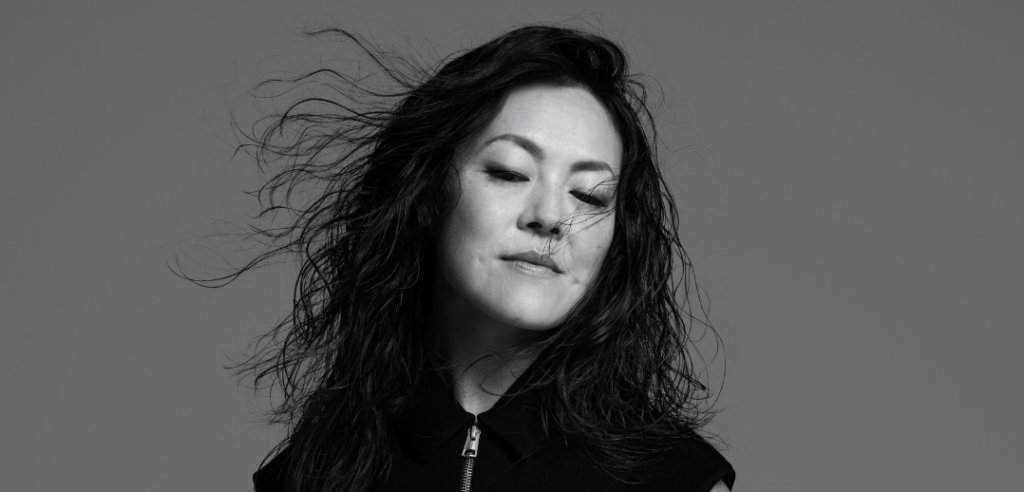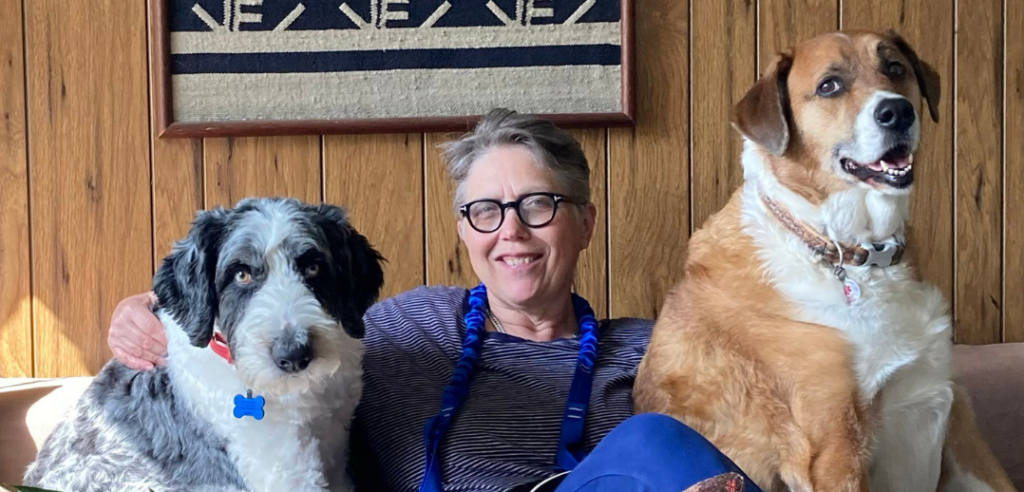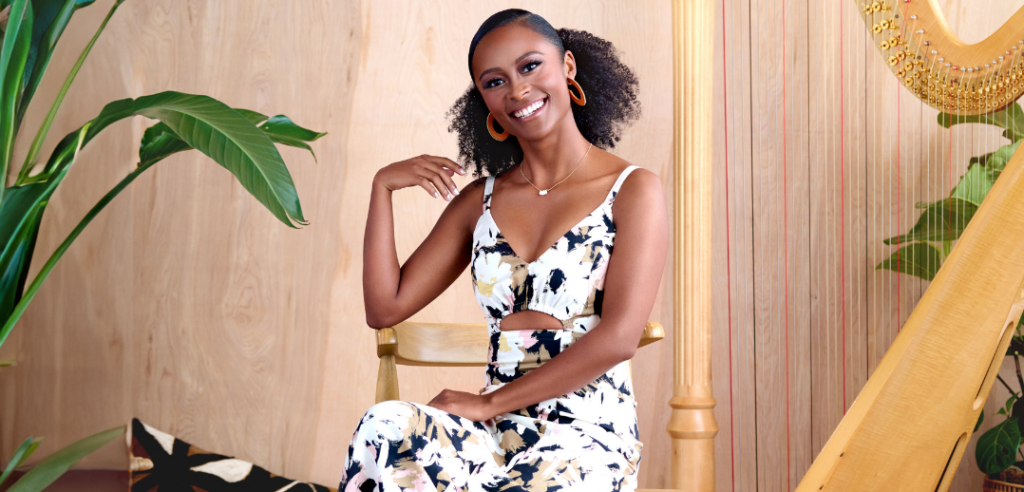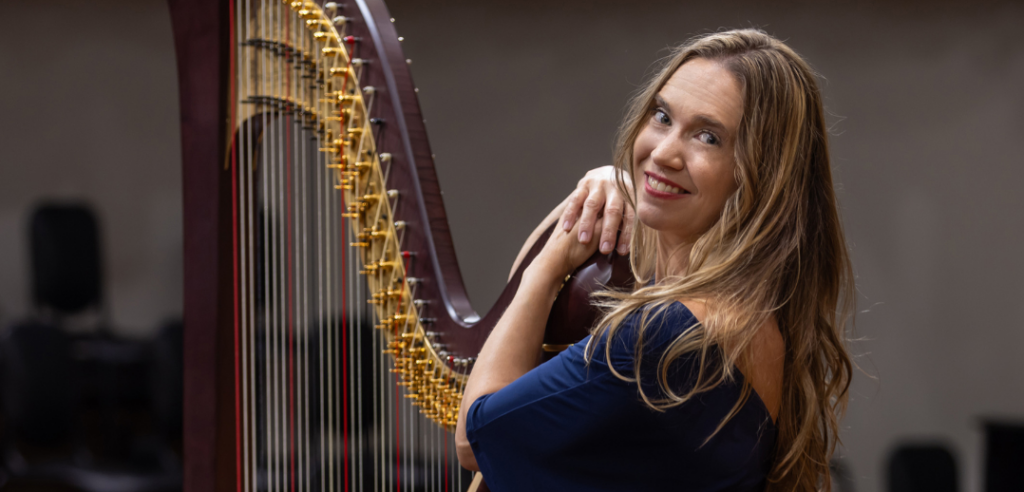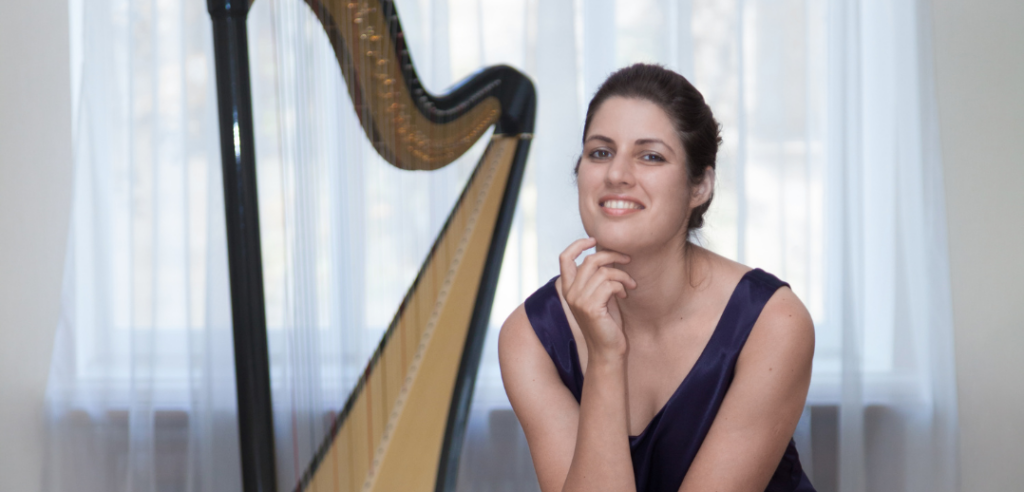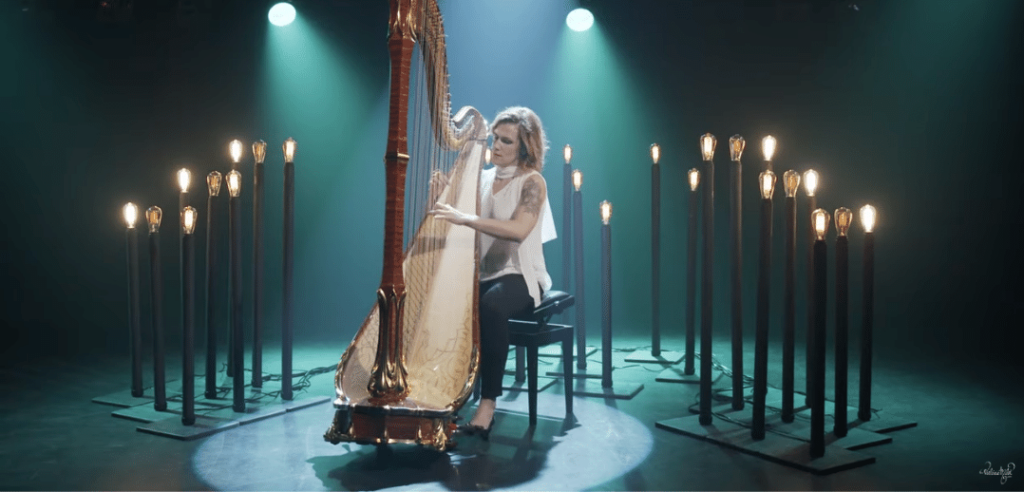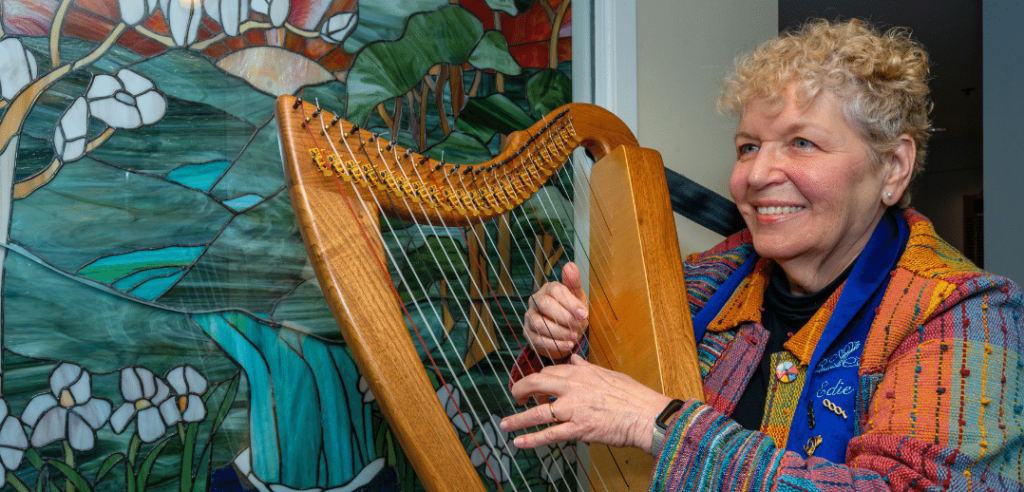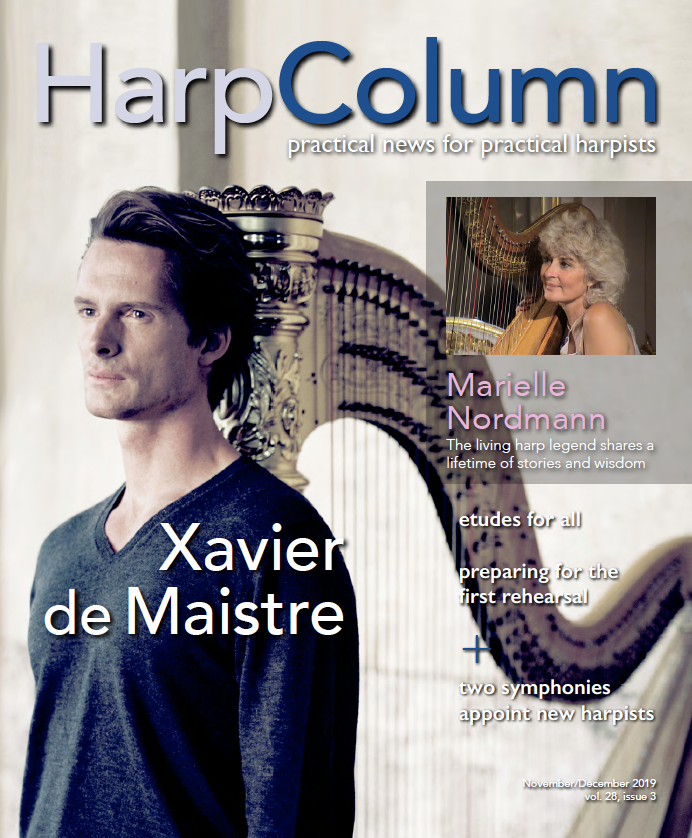There is no question Marielle Nordmann is one of the grand dames of the harp—a living legend whose musical reputation is unsurpassed. Her many recordings have served as a masterclass in how to craft sound and musical nuance. For years she led the Nordmann trio with flutist André Guilbert and cellist Renaud Fontanarosa. Her international solo career took her all over the world. But to understand Marielle Nordmann’s music, you must first understand the strongest influence in her life—her teacher, Lily Laskine. Nordmann studied with Laskine at the Paris Conservatory, where Nordmann won the premiér prix in 1958. Her relationship with Laskine remained close until Laskine’s death in 1988. In 1995, Nordmann created the Lily Laskine Competition in memory of her teacher and mentor.
Myriam Serfass sat down with Nordmann to talk about her storied career in music and her relationship with the great Lily Laskine.
Harp Column: Tell us about your studies with Lily Laskine and your relationship with her.
Marielle Nordmann: To study with Lily Laskine was to be in permanent contact with all the exceptional qualities of this very great personality: her intelligence, kindness, humor, wittiness, calm, patience, and psychology. Over time, what was created between this great lady and I was a relationship of tenderness on her part, and devotion and then love on my part. It was more a relationship of disciple to master than of student to professor, so much her teaching took part through how she lived her life. Her insatiable curiosity for all things was matched only by her great openness. Her credo for the life of a musician was this: “Do everything life offers you—from the most insignificant things to the most important things. You will be enriched by all the different personalities you will encounter in all these situations.” She performed very often for humanitarian or charitable organizations, being a good example to her students. She was as comfortable in a symphony orchestra as in a variety orchestra playing French pop songs where she particularly liked to accompany the great French singers after the War—Yves Montand, Jacques Brel, Michel Sardou, Edith Piaf, etc.
Her listening was exceptional, as much when we played the harp as when we spoke with her. She always focused on the basics and always in a positive way. Her lessons were exciting and rewarding—I went home after the lessons with the desire to get back to work immediately to improve everything and especially to make her happy. Her radiant personality dazzled the child that I was, and I aspired, with all my strength, to resemble or be like her. She immediately gave me absolute confidence and from the age of 13 sent me out to play for some [little easy gigs] instead of playing them herself. It is thanks to her that I learned the great diversity of a musician’s life at a very early age. I have woven with her unforgettable and exceptional links, having remained at her side for 35 years as a child, a young student, an older, more serious student, a musical partner, and friend, and always with the same happiness, the same love, the same respect. For 10 years I played in a duet with this tiny lady with sparkling navy blue eyes, who will certainly be remembered as one of the greatest artists of the 20th century.
HC: What are the most valuable lessons you learned with Lily Laskine?
MN: I learned to be positive in all situations, to listen to my intuition, and to always do my best, even if my “best” changes all the time. I also learned modesty, patience, humor, generosity, simplicity, listening, respect, life, work, friendship, and the accuracy of musical interpretation. When she taught, she would make musical proposals, and if we did not agree, she would say, “It does not matter, you’ll do it later; you’ll see!” It was true!
HC: Tell us about your time at the Paris Conservatory.
MN: I was very young—I was there from age 11 to 16. I certainly did not have a real vision of what education was at that time. I only remember that the instrument was in the foreground and there was less mandatory presence on a daily basis. Harp studies were the most important in the Conservatory studies. Students did not need to be present in the Conservatory for so many other lessons, as it seems to be today. Students had more time to play the harp.
Of course, I had to take courses in music theory, harmony, history of music, and general education. I was a very shy and timid child, and my teachers (other than Lily Laskine) were terrified at the thought that I would burst into tears at the slightest reprimand. On the other hand, I remember that there was a magnificent freedom in Lily Laskine’s class and a very good understanding between the students. During my four years of study in the classroom, I remember going through a very large number of musical works. I learned and played a lot of music during these four years, the idea being to make me discover as much as possible of different works. My musical curiosities were insatiable. Even if a piece was not completely mastered, I would take another new piece so that I could know a lot of music. It was a wonderful motivation for me. There was also an accompanying pianist for her class. I absolutely loved to play concertos, accompanied by the piano.
On creating the Lily Laskine Contest: It was important to me to keep her values intact and choose a program based on musicality and not on technique.
HC: Why did you create the Lily Laskine contest, and what has it brought?
MN: I had the heart to create this contest to perpetuate her name and her memory, similar to what was imagined by the creators of the competitions for Rostropovich, Menuhin, Rampal, etc. It was important to me to keep her values intact and choose a program based on musicality and not only on technique. It was important to imagine a “diverse” jury of harpists as well as other musicians who know nothing about harp technique and would judge only on the music. It was important to commission new works from contemporary composers who have now become part of the harps’ repertoire—Hersant, Bacri, Charpentier, Benzecry, Connesson, etc. I wanted to create, for the first time, a junior division of an international competition. Among the first winners of the junior competition were Varvara Ivanova and Anneleen Lenaerts. It was also important to favor an atmosphere of camaraderie rather than competition. In creating this contest, my goal was also to make it a personal challenge rather than a competition. Each candidate would be assured of being always listened to with respect and attention for the work provided. As an African Olympic champion said, “I do not like competitions because if the winner smiles, all the others cry.”
HC: What role should competitions play in the development of a musician?
MN: The most important path that is made on a program is the one that is made in relation to oneself. The result is not only in the hands of the person who performs—it is listened to by a jury of very different personalities, and that is why it is so difficult to agree on the final result. What I like least about competitions is this notion of competition against others. Art is not competitive because each artist has something personal to contribute, and all these differences enrich the world of music. A contest can provide insight into a musician’s own level compared to the international level and that of other musicians, an obligation to perform a program at its highest level, through particularly refined work, and an opportunity to be heard and noticed by great artists.
HC: What can young people gain from working with you?
When I work with a young musician, I do not have the notion of ownership at all. I hope to bring them musical freedom and confidence. I hope to teach them to listen to their hearts, to let their feelings emerge, to follow their dreams, to think of their music as their life.
MN: “It’s not me who teaches, it’s you who learns”. (Editor’s note—Nordmann gives a philosophical idea about master and disciple/follower, where the master is not the one who teaches, but instead the student is the one who wants to learn. The idea is that the master is only a master if a disciple or follower decides to take her as a master and follows the master.) When I work with a young musician, I do not have the notion of ownership at all. I hope to bring them musical freedom and confidence. I hope to teach them to listen to their hearts, to let their feelings emerge, to follow their dreams, to think of their music as their life. Creating music is like creating love, like playing your own life. I think it’s very important to let the young musician find his own interpretation by guiding him, not imposing. I mostly try not to make a clone of myself, but let them be free artists, able to play music that makes people vibrate and touch hearts. I hope to teach them the power of music, even in the heart of the most difficult situations, and be a point of support to grow in their own lives. I hope to be able to transmit to them the joy of playing, the joy of living, the happiness of making others happy, the search for beauty, and also teach them that music makes them kind, alive, and beautiful! And as one great young harpist recently wrote to me, “Thank you for teaching me to speak with my heart.”
HC: How have young students and music education changed?
MN: The teaching has not changed; it is the teachers who change, and sometimes, maybe, the goal changes. We have to go always faster, always stronger, always higher. The instrument becomes “sporty,” but there is always the same percentage of potential artists. (Ed.—Nordmann believes virtuosity, speed, and strength seem sometimes to be more important than music. The one who goes faster, gets all the notes and rhythms sometimes wins, but what about music? Nordmann believes musicians and harpists train themselves for a competition like athletes train for the Olympics, being the best at the moment instead of trying to play as musically as they can, and improve their sensibility and their connection to music.) We play better, more perfectly, more technical, better, better, better, but the development of feelings did not change. Teachers always teach what they are. Young people move from one teacher to another, but what are they really looking for when they change teachers so often? Themselves! However, it seems to me that the urgency of the global situation creates the incentive for students to go further in their desire for sharing, for beauty, for selflessness, and for altruism. •
















